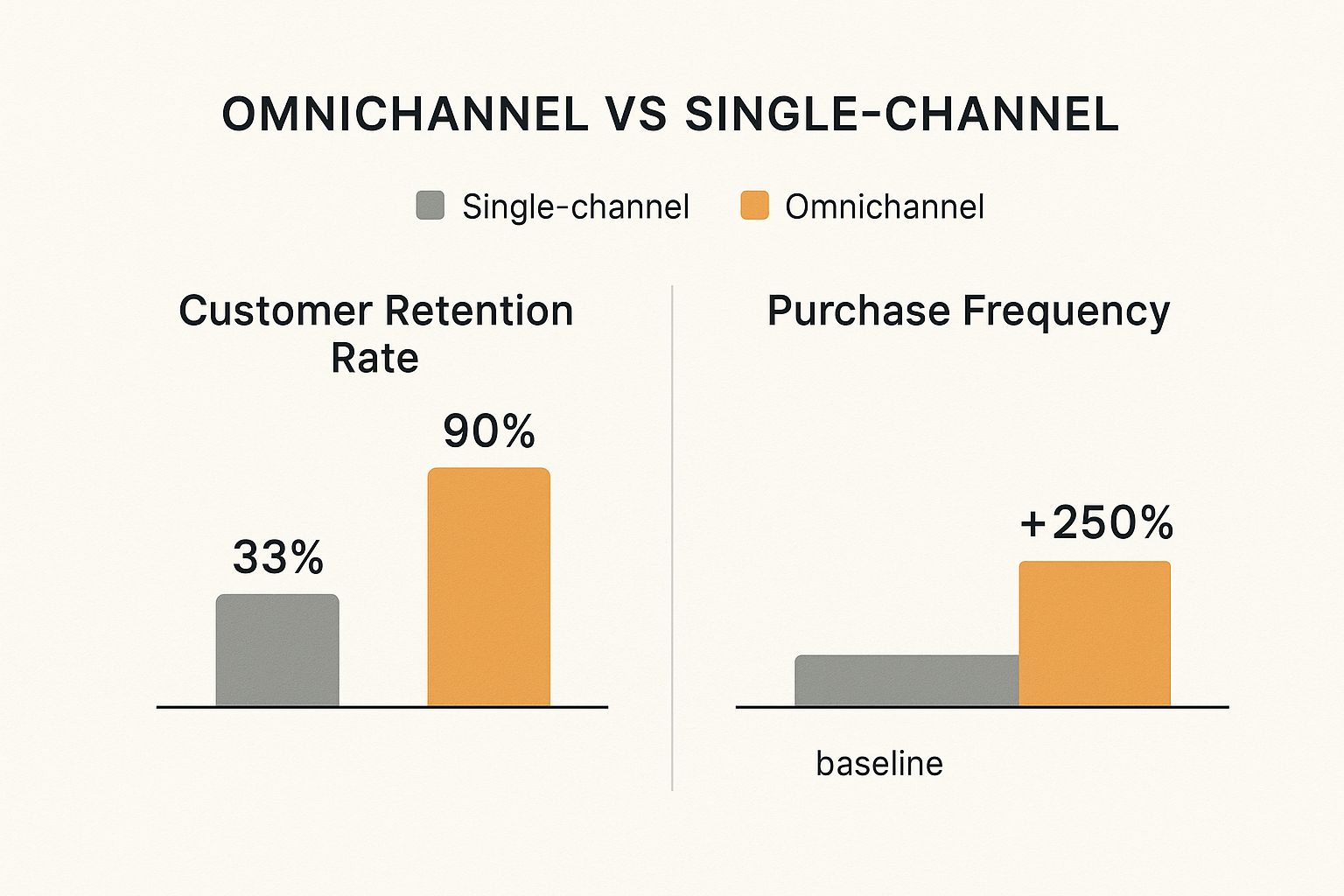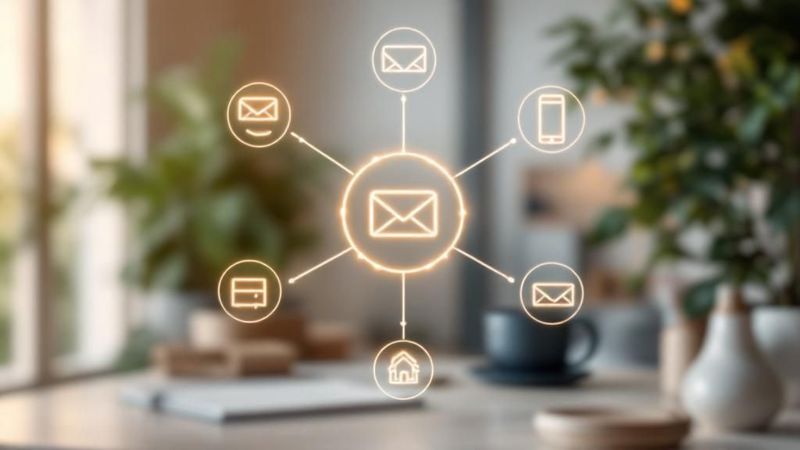Omnichannel marketing is all about creating one seamless, continuous conversation with your customers, no matter where they interact with you. Think of it as making sure your brand speaks with one voice—whether someone is browsing your website, visiting a store, or scrolling through social media. This approach puts the customer, not the channel, at the heart of everything you do.
Omnichannel vs Multichannel vs Single-Channel Marketing
To really get what makes omnichannel so effective, it helps to see how it stacks up against other common marketing approaches. Many businesses start with a single channel, expand to multichannel, but the real magic happens when they evolve to a true omnichannel strategy.
The table below breaks down the core differences:
| Attribute | Single-Channel | Multichannel | Omnichannel |
|---|---|---|---|
| Strategy Focus | One channel (e.g., physical store only) | Multiple, but separate, channels | All channels integrated as one |
| Customer Experience | Consistent on one channel | Inconsistent and fragmented across channels | Seamless and continuous across all channels |
| Business Focus | Product-centric | Channel-centric | Customer-centric |
| Data & Insights | Limited to one channel's performance | Data is siloed by channel | Centralized data, providing a 360-degree customer view |
| Primary Goal | Drive sales through a single touchpoint | Maximize reach on individual channels | Enhance customer lifetime value and loyalty |
Ultimately, single-channel is limiting, and multichannel often creates frustrating, disconnected experiences. Omnichannel is the only approach designed from the ground up to reflect how modern customers actually shop—by moving fluidly between online and offline worlds.
So, What Is Omnichannel Marketing at Its Core?
At its heart, omnichannel marketing is a philosophy that treats every customer interaction as part of a single, unified journey. It’s more than just being present on multiple platforms; it’s about making those platforms talk to each other.
Imagine a customer sees a product on your Instagram feed. Later that day, they add it to their cart on your website but don’t check out. With an omnichannel approach, they might get an email reminder about it. That email could also mention they can see the item in person at their nearest store, creating a fluid, helpful, and completely connected experience.
This integration isn't just a nice-to-have; it's what keeps customers coming back. The data speaks for itself.

As you can see, the difference is massive. A well-executed omnichannel strategy can lead to a nearly 3x higher customer retention rate and a huge jump in how often customers make a purchase.
From Multiple Channels to a Single Experience
A lot of businesses operate on a multichannel basis, which means they use several platforms that don't communicate with each other. This creates disjointed experiences where the online team has no idea what the in-store team is doing. It's frustrating for everyone.
The omnichannel model fixes this by weaving all those separate threads into a single tapestry.
The goal is to make the jump between channels so smooth that the customer doesn't even notice it. It should all feel like one continuous interaction with your brand, regardless of the platform.
For example, a customer service agent can see a shopper's recent online activity and in-store purchases, giving them the context to provide truly helpful support without the customer needing to repeat their life story. This level of deep integration is what separates a basic multichannel presence from a true omnichannel strategy.
In fact, companies with strong omnichannel strategies see customer retention rates of around 89%, compared to a meager 33% for businesses with weaker approaches. You can dig into more of these powerful omnichannel shopping statistics to see the full picture.
The Building Blocks of a Winning Omnichannel Strategy

Building a seamless omnichannel experience is like assembling a jigsaw puzzle—every piece matters. If you skip even one, the picture feels incomplete and customers sense the gaps instantly.
At the core of this puzzle sits a unified customer profile, a single source of truth that stitches together store visits, site clicks, chat logs, and social interactions into one coherent story.
With that 360° view in hand, you can anticipate needs, tailor outreach, and drive relevance at each step of the journey. For a deeper dive into personalization’s role, see our guide on what is personalization in marketing.
Consistent Messaging Across All Channels
Once you know who your customers are, consistency becomes your best friend. Whether someone taps on your mobile app, opens an email, or chats with support, the brand should sound and look the same.
Think of your brand’s messaging as a single thread—pull it on one channel, and the tension must hold tight everywhere else. Key elements include:
- Voice and Tone: Align the style in emails, posts, and in-store conversations.
- Visual Identity: Stick to the same color palette, logo placement, and fonts.
- Core Promise: Ensure the deal you advertise on social matches what customers find in person.
When each touchpoint echoes the same promise, trust grows—and confusion fades.
An Integrated Technology Stack
Behind every smooth omnichannel interaction is an operational backbone: your tech stack. CRM, e-commerce, marketing automation, and customer support tools need to share data in real time.
This integration is what makes a seamless experience possible. It’s the behind-the-scenes magic that ensures a customer’s abandoned online cart is visible to an in-store associate, turning a potential lost sale into a saved one.
B2C marketers typically juggle five channels. The front-runners are:
- Email (82.4%)
- Social Media (66.7%)
- Mobile Websites (58%)
Fusing these channels with strong search engine optimization best practices keeps your brand discoverable and drives traffic across every touchpoint.
Discover more about how AI is impacting omnichannel marketing strategies on moengage.com for practical insights on elevating your own approach.
Real Examples of Omnichannel Marketing Done Right

Theory is great, but seeing omnichannel marketing in the wild is where it all clicks. The best way to really get it is to look at brands that have mastered the art of weaving their different channels into one seamless customer experience.
These companies prove that when your online and offline worlds talk to each other, the customer wins. They’ve connected every touchpoint—from that first social media ad to an in-store pickup—making the entire journey feel completely natural.
A perfect example is a major cosmetics retailer that beautifully merges its mobile app and its physical stores. You can be in the aisle, scan a product with the app, and instantly see customer reviews or even use your phone’s camera to virtually try on a shade of lipstick. It’s a digital layer that makes the in-store visit so much richer.
Connecting Digital Carts to Physical Stores
Another masterclass in omnichannel comes from a global coffee chain. Their mobile app is the engine of their entire experience. You can order and pay ahead, rack up loyalty points, and get personalized offers, all before you even leave your car.
When you walk through the door, your order is waiting, your name is on the cup, and your loyalty points are already updated. The app and the cafe aren't two separate things; they're just two parts of a single, fluid transaction. That’s how you build a habit and keep people coming back.
The big idea here is simple but powerful: meet people where they are and make their lives easier. The tech should just disappear into the background, leaving behind a smooth and positive interaction with your brand.
Pulling this off means you have to know your customers inside and out. Some of the key plays these brands run include:
- Click-and-Collect: The classic "buy online, pick up in-store" model that gives customers the best of both worlds.
- Unified Inventory: Letting online shoppers and store employees see real-time stock levels across every single location. No more disappointment.
- Connected Loyalty Programs: Making sure points and rewards sync up instantly, whether the purchase happens online, in the app, or at the register.
These examples are just the tip of the iceberg. If you want to go deeper, check out these inspiring digital marketing campaigns for more creative ideas. By studying what the leaders are doing, you can start to piece together a powerful strategy of your own.
How Disconnected Customer Service Breaks the Experience
Even the most brilliant marketing strategy can fall apart at the first sign of friction. An omnichannel approach is supposed to create a smooth, connected journey, but that promise shatters the moment a customer needs help and gets lost in a support maze.
We’ve all been there. You start a query with a chatbot, then need to talk to a real person, only to have to explain your entire story all over again. That kind of disconnect doesn't just waste time; it erodes trust and makes your customer feel completely invisible.
This isn’t just a minor hiccup—it’s a massive business problem. When your support channels don't talk to each other, the entire experience feels clunky and disjointed, undoing all the hard work your marketing team put into building that seamless journey.
The High Cost of Siloed Support
A disconnected service model treats every interaction as a brand-new event, completely ignoring the customer's history and context. This forces the customer to do all the heavy lifting, connecting the dots between your own internal departments.
That friction leads directly to bad experiences and, eventually, customer churn. It's a bigger deal than you might think—research shows that a staggering 56% of customers have to repeat their issues when they move between a company's support channels.
On the flip side, companies that nail an integrated omnichannel service model see a customer satisfaction score of 67%. That's more than double the 28% for businesses stuck with disjointed, multichannel approaches. You can dig deeper into these omnichannel service statistics on plivo.com.
True omnichannel support means a service agent can instantly see a customer's recent purchases, past support tickets, and even what’s sitting in their online cart. This context turns a frustrating interrogation into a genuinely helpful conversation.
This unified view is the secret sauce for real engagement. When you understand a customer's full story, you can offer proactive solutions and build a truly personal connection. Our guide on marketing personalisation dives into how this deeper context helps create much stronger customer relationships.
At the end of the day, omnichannel isn't just about selling everywhere; it's about supporting customers intelligently and consistently, no matter where they are in their journey.
Your Omnichannel Marketing Questions, Answered
As you start thinking about what an omnichannel approach could look like for your business, a few questions always seem to pop up. Let's clear up some of the common points of confusion so you can move forward with confidence.
What’s the Real Difference Between Omnichannel and Multichannel?
The biggest difference comes down to one thing: customer focus.
Multichannel marketing is pretty straightforward—it just means you’re using more than one channel to talk to people. But the key issue is that those channels usually operate in their own little worlds. Your social media team might not have a clue what your email team is sending, and neither knows what’s happening in your physical store. It's a siloed approach.
Omnichannel blows up those silos. It integrates every channel to create a single, continuous conversation with the customer.
The real shift is from being channel-focused to being customer-focused. An omnichannel strategy makes sure the customer's journey feels consistent and logical, no matter how they choose to interact with your brand.
Think of it like picking up a conversation with a friend right where you left off, even if you switch from texting to a phone call. The context carries over, and the experience is seamless.
Is Omnichannel Just for Big Retail Companies?
Absolutely not. While giant retailers like Sephora and Starbucks are often the poster children for omnichannel, the principles work for any business that interacts with customers in multiple places. This includes B2B companies, SaaS platforms, local service businesses, and even healthcare providers.
If your customers find you through your website, follow you on social media, get your emails, and talk to your sales team, you have an opportunity to connect those dots. It’s not about company size; it’s about creating a better, more cohesive experience for the people you serve. The first step is simply mapping out the journey your customers actually take and connecting the channels they use most.
What's the First Step to Building an Omnichannel Strategy?
Before you even think about new software or team reorganizations, your first step is to get inside your customer's head. You need to deeply understand and map their journey from their perspective.
Start by identifying every single touchpoint where a customer interacts with your brand.
- Map the entire journey: Document every step, from the moment they first hear about you all the way through to post-purchase support.
- Identify friction points: Where do things get clunky? Pinpoint where the experience feels disconnected, frustrating, or repetitive for them.
- Listen to what they're telling you: Dive into surveys, read online reviews, and analyze support tickets to find their biggest pain points.
This map becomes your blueprint. It shows you exactly where the gaps are and tells you which channels to connect first to make the biggest impact. It’s all about removing that friction to create an experience that feels completely natural.
Ready to make every customer interaction personal? With OKZest, you can automatically create stunning, personalized images for your email campaigns, social messages, and more. See how easy it is to boost engagement and build stronger relationships at https://okzest.com.